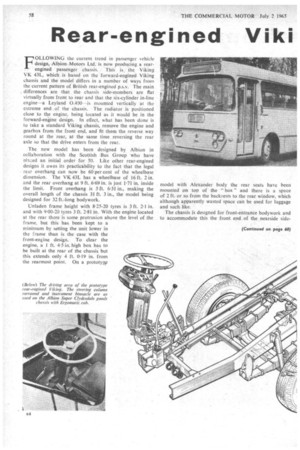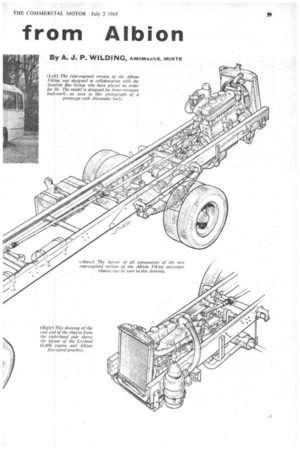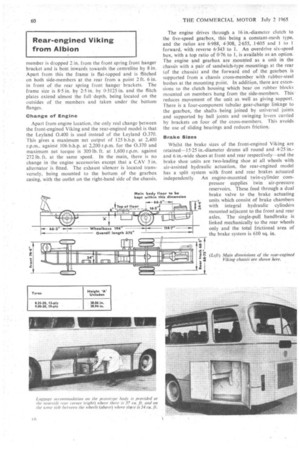Rear-engined Viki from Albion
Page 60

Page 61

Page 62

Page 63

If you've noticed an error in this article please click here to report it so we can fix it.
By A.J. P. WILDING, AIVIIMechE, MARTE FOLLOWIENG the current trend in passenger vehicle design, Albion Motors Ltd. is now producing a rearengined passenger chassis. . This is the Viking VK 43L, which is based on the forward-engined Viking chassis and the model differs in a number of ways from the current pattern of British rear-engined p.s.v. The main differences are that the chassis side-members are at virtually from front to rear and that the six-cylinder in-line engine—a Leyland 0.490--is mounted vertically at the extreme end of the chassis. The radiator is positioned close to the engine, being located as it would be in the forward-engine design. In effect, what has been done is to take a standard Viking chassis, remove the engine and gearbox from the front end, and fit them the reverse way round at the rear, at the same time reversing the rear axle so that the drive enters from the rear.
The new model has been designed by Albion in collaboration with the Scottish Bus Group who have ola...:ed an initial order for 50. Like other rear-engined designs it owes its practicability to the fact that the legal reAr overhang can now be 60 per cent of the wheelbase dimension. The VK 43L has a wheelbase of 16 ft. 2 in. and the rear overhang at 9 ft. 6-69 in. is just 1.71 in. inside the limit. Front overhang is 5 ft. 6-31 in., making the overall length of the chassis 31 ft. 3 in., the model being designed for 32 ft.-Iong bodywork.
Unladen frame height with 8-25-20 tyres is 3 ft. 2-1 in. and with 9.00-20 tyres 3 ft. 2.81 in. With the engine located at the rear there is some protrusion above the level of the frame, but this has been kept to a minimum by setting the unit lower in the frame than is the case with the front-engine design. To clear the engine, a 1 ft. 4.5 in. high box has to be built at the rear of the chassis but this extends only 4 ft. 0.19 in. from the rearmost point. On a prototyns model with Alexander body the rear seats have been mounted on top of the "box" and there is a space of 2 ft. or so from the backrests to the rear window, which although apparently wasted space can be used for luggage and such like.
The chassis is designed for front-entrance bodywork and to accommodate this the front end of the nearside side member is dropped 2 in. from the front spring front hanger bracket and is bent inwards towards the centreline by 8 in. Apart from this the frame is flat-topped and is flitched on both side-members at the rear from a point 2 ft. 6 in. in front of the rear spring front hanger brackets. The frame site is 8.5 in. by 2.5 in. by 0-3125 in and the flitch plates extend almost the full depth, being located on the outsides of the members and taken under the bOttom flanges.
Change of Engine Apart from engine location, the only real change between the front-engined Viking and the rear-engined model is that the Leyland 0.400 is used instead of the Leyland 0.370. This gives a maximum net output of 125 b.h.p. at 2,400 r.p.m., against 106 b.h.p. at 2,200 r.p.m. for the 0.370 and maximum net torque is 300 lb. ft. at 1,600 r.p.m. against 272 lb. ft. at the same speed. In the main, there is no change in the engine accessories except that a CAV 5 in. alternator is fitted. The exhaust silencer is located transversely, being mounted to the bottom of the gearbox casing, with the outlet on the right-hand side of the chassis. The engine drives through a 16 in.-diameter clutch to the five-speed gearbox, this being a constant-mesh type, and the ratios are 6.98,8, 4-308, 2-655, 1-605 and 1 to forward, with reverse 6.343 to 1. An overdrive six-speed box, with a top ratio of 0.76 to 1, is available as an option. The engine and gearbox are mounted as a unit in the chassis with a pair of sandwich-type mountings at the rear (of the chassis) and the forward end of the gearbox is supported from a chassis cross-member with rubber-steel bushes at the mounting point. In addition, there are extensions to the clutch housing which bear on rubber blocks mounted on members hung from the side-members. This reduces movement of the unit as well as giving support. There is a four-component tubular gear-change linkage to the gearbox, the shafts being joined by universal joints and supported by ball joints and swinging levers carried by brackets on four of the cross-members. This avoids the use of sliding bearings and reduces friction.
Brake Sizes Whilst the brake sizes of the front-engined Viking are retained-15.25 in.-diameter drums all round and 4.25 in.and 6 in.-wide shoes at front and rear respectively—and the brake shoe units are two-leading shoe at all wheels with air-assisted hydraulic actuation, the rear-engined model has a split system with front and rear brakes actuated independently. An engine-mounted twin-cylinder compressor supplies twin air-pressure reservoirs. These feed through a dual brake valve to the brake actuating units which consist of brake chambers with integral hydraulic cylinders mounted adjacent to the front and rear axles. The single-pull handbrake is linked mechanically to the rear wheels only and the total frictional area of the brake system is 610 sq. in.
1141"
The suspension on the new model is basically the same as on the front-engined design, with front springs 4 ft. 6 in. long by 3 in. wide and rears 5 ft. long by 15 in.: but because of the different engine location the rear-spring mounting layout is reversed, with the fixed eyes at the rear end and the swinging shackles at the forward end. Telescopic dampers are standard at the front axle.
The steering box is a Burman recirculatory-ball unit and a commendable feature is that the steering column shroud and instrument nacelle from the Albion version of the Leyland Group Ergonomic cab are used. This provides the advantage that all the electrical connections, fuses and so on are located in a compartment in the shroud. The electrical system is 24 V.
Except that the rear axle is reversed in the chassis. front and rear axles from the front-engined Viking are retained for the rear-engined model. The rear axle has a spiralbevel primary drive with secondary reduction by epicyclic gear trains in the hubs. The hub reduction is 4 to I and input gears with various ratios provide optional overall ratios of 54)44, 5.555 and 6-25 to 1.
A square-section fuel tank with a capacity of 30 gal. is mounted on the right-hand chassis side-member close to the rear axle and provision is made for the batteries to be mounted in between the chassis side-members. Standard tyres are 8.25-20, 12-ply on eight-stud wheels and 9.00-20, 12-ply are available as optional equipment.
Seating plans have been reproduced of two versions of the body now being fitted by Walter Alexander and Co. (Coachbuilders) Ltd. One is a long-distance coach for journeys such as Scotland to London, and seats 34 passengers. All seats are forward of the raised portion covering the engine at the rear of the bus.
The dual-purpose bus has 40 seats, the rearmost row of four seats being arranged over the engine compartment, with access on the offside to the emergency exit.
The initial production of bodies on the rear-engined Albion will be allocated as follows: Scottish Omnibuses Ltd., 12 34-seat long-distance coaches; W. Alexander and Sons (Midland) Ltd., eight similar vehicles: W. Alexander and Sons (Fife) Ltd., one. and 11 dual-purpose buses; W. Alexander and Sons (Northern) Ltd., 15 40-seaters and three similar buses not yet allocated.
























































































































